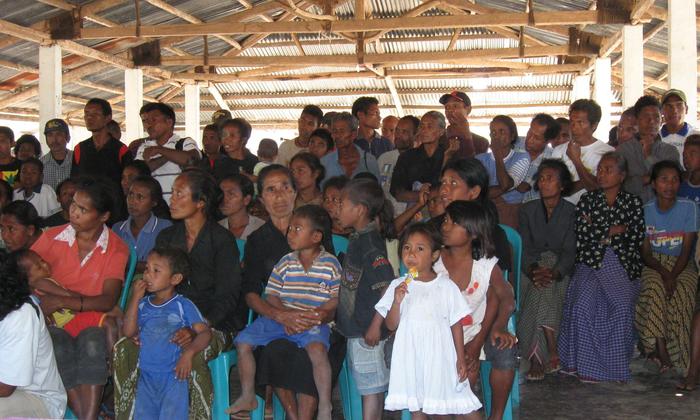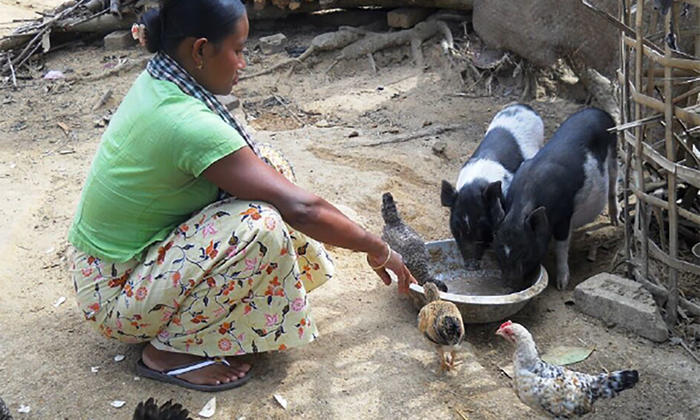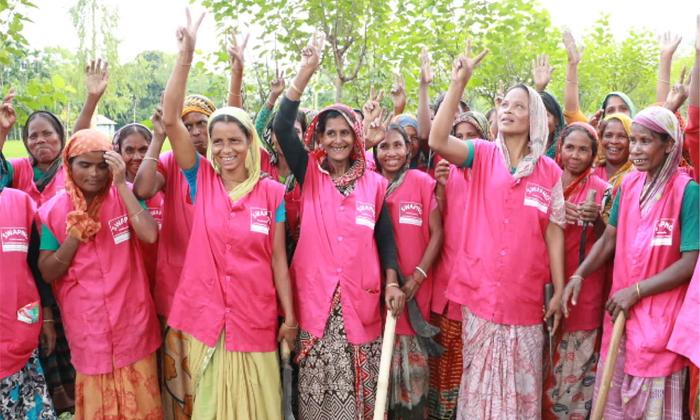One of the fundamental causes of the Salvadoran people’s food deficit is an inadequate food intake, which is a result of their low purchasing power and a poor traditional diet based on corn tortillas with salt or beans, or rice and wild vegetables
Case study
Institutional strengthening to improve food security and nutrition in El Salvador

SDGs ADDRESSED
This case study is based on lessons from the joint programme, Protecting children: towards a coordinated food security and nutritional programme for El Salvador
Read more
Chapters
Project Partners



1. SUMMARY
The objective of the intervention was to contribute to strengthening the Salvadoran institutions responsible for nutrition and food security, by facilitating spaces for dialogue and building agreements, as well as coordinating actions at local and national level to develop a State policy on children and nutrition.
With this aim, the programme provided technical and financial support for the National Council on Food Security and Nutrition (CONASAN), which has responsibility for coordinating policies on food security. By strengthening the institution and its Technical Committee (COTSAN), significant tasks such as the development of the draft bill on nutrition and food sovereignty and security were carried out. At local level, work was done with communities to promote the creation of governance structures that would facilitate institutional dialogue and exercise of the right to a healthy diet. These structures culminated in the incorporation of the nutrition issue into local development policies, and in the creation and strengthening of multi-sector municipal committees (CMI). The most urgent needs in the Department of Morazán (Cacaopera, San Simón and Guatajiagu) were also addressed by improving agricultural productivity, access to food and diet diversification for the most vulnerable groups.
This case study analyses the practices, lessons learned, outcomes and challenges from the methodology that led to the strengthening of CONASAN. Through this study we aim to reinforce and expand the knowledge available on institutional strengthening as a means of improving nutrition and food security.

Beneficiary families received seeds and fertilizers to improve the variety and quality of their produce
2. THE SITUATION
Although there have been many sector strategies in El Salvador on nutrition and food security, the Salvadorans continue to have a food deficit and nutritional problems associated with excess calories in the diet. According to the National Weight and Size Survey in 2007, chronic malnutrition in children under the age of five reached 10.62 per cent in urban areas and 19.21 per cent in rural areas. In 2003, the prevalence of anaemia was 19.8 per cent, while in 2008 it rose to 23 per cent nationally and 26 per cent in rural areas. In addition to this, extreme poverty rose to 6.5 per cent in the same year due to the rapid decrease in remittances and the increase in the price of food and fuel. This meant that 87 per cent of poor households had to reduce their food intake.
One of the fundamental causes of this problem is an inadequate intake of food, caused by low purchasing power1 and inadequate eating habits. In this regard, the traditional Salvadoran diet is based on corn tortillas with salt or beans, and to a lesser extent rice and wild vegetables. This diet is even more deficient for women, who generally give most of their food to their husband and children2. In this context, some population groups do not have a strong immune system and so are very susceptible to illness.
In recent years actions arising from public policies have been focused on formulating vertical plans that address problems on the basis of different themes, such as health, agriculture, education and children. The lack of a horizontal policy resulted in problems of coherence, interaction and coordination, leading to a duplication of effort and consequently an inefficient use of resources. Two important lessons were learned from these efforts: 1) the need to have a governing body which has an integrated approach to the problems, and 2) the need to construct a horizontal multi-sector policy at national level with an impact that is measurable at local level.
On 16 October 2009, as part of World Food Day, the president of El Salvador, Mauricio Funes, inaugurated CONASAN, thereby paving the way for the construction of an institutional environment that would allow a multi-sector focus. However, the process of setting up CONASAN was not very effective. The institutions which were part of CONASAN did not have a clear understanding of their own role, and coordination between the stakeholders was poor. There was no clarity or consensus on the multiple causes of the problem, and there was no systematised information for decision-making. Consequently, in its second semester a leadership vacuum was created in CONASAN’s Executive Directorate, which meant in practice that actions ground to a halt.
1 The average cost of a basket of basic groceries in the first three months of 2009 was more than 80 per cent of the minimum urban salary.
2 National Salvadoran Indigenous Coordinating Council (CCNIS). Pan American Health Organization in El Salvador Pueblos Indigmins Sakid v Oiklad:db Viila in EI Salvador.1999
3. STRATEGY
The programme was designed with intervention logic at two levels: national and local. At national level, the strategy focused on the implementation of the national SAN (Nutrition and Food Security) policy and on the institutional strengthening of CONASAN3 and other national stakeholders. The first step consisted of carrying out an analysis of the institution’s strengths and weaknesses, which was used to design a work plan containing the following actions:
- Design of the CONASAN strategic framework.
- Strengthening CONASAN’s technical skills.
- Strengthening the legal framework, by supporting the revision of the draft bill on nutrition and food security.
- Creation of spaces for reflection.
- Sensitisation and training of workers, leaders, civil society and the media on the issues of food security.
At local level, the country’s most urgent nutritional needs, found in the Department of Morazán (Cacaopera, San Simón and Guatajiagu)4 were addressed through improved agricultural productivity, increased access to food and diversification of the diet for the most vulnerable groups. A policy on decentralisation and citizen participation was also implemented by setting up the National Council for Regional Development.
4 According to the National Family Health Survey (FESAL, 2008), the level of chronic malnutrition in the Department of Morazán was 24.7 per cent. The three selected municipalities had almost double the national percentage of growth retardation in schoolchildren aged between 6 and 9 years (Height Census, 2007). The levels of growth retardation found in the municipalities were: Cacaopera 40.8 per cent, San Simón 36.65 per cent and Guatajiagua 35.3 per cent.

Diets are usually poorer for women who give up most of the food for their children and husbands
4. RESULTS AND IMPACT
The programme contributed to the implementation of the National Nutrition and Food Security Policy and to the institutional strengthening of CONASAN, which positioned itself as the governing body for food security in El Salvador. The mission, vision and strategy were defined, featuring eight strategic objectives and four cross-cutting themes (health, education, gender and the environment), along with their corresponding lines of action, outcomes and definition of roles. This was accompanied by an inter-sector operational plan that included short, medium and long-term actions, and involved the various associated government sectors. An inter-sector coordination strategy was also established with four phases and mechanisms to achieve effective coordination. As a form of support, the Technical Team (COTSAN) received training through the Diploma Course in Food Security from the University of El Salvador and the Doctor Andrés Bello University.
Support was given to strengthening the legal framework through the revision of the draft bill on nutrition and food security, involving several stakeholders such as the Pan-American Alliance for Nutrition and Development, the Office of the Procurator for the Protection of Human Rights, and the Social and Economic Council, as well as other groups of women, producers, and government and non-government organizations associated with nutrition and food security. At the time this case study was written, the Legislative Assembly was in the process of debating the Law on Food and Nutritional Sovereignty and Security.
Some of the main achievements at national level are listed below:
- Creation of spaces for reflection: A forum (FOROSAN) was set up in the northeastern area as a permanent space for discussions on nutrition and food security. The Observatory for Nutrition and Food Security was designed to have various units, including an information system, a stakeholder map, a virtual library and news bulletins to make CONASAN’s daily activities visible.
- Staff training at central, departmental and municipal levels. Some 550 government officials from the Ministry of Education, university teachers, civil society and the media were sensitised and trained in nutrition and food security at national level.
- Development of a nutrition information system with 66 indicators for health, education, nutrition and agriculture, disaggregated by gender and ethnic group, for the formulation of policies, programmes and projects for the well-being of children and their families. The participation of numerous stakeholders in developing the information system contributed to raising awareness of the multiple causes of the problem.
- Carrying out two studies in conjunction with the Breastfeeding Support Centre: the first on the economic advantages of breastfeeding in El Salvador, and the second on the current breastfeeding situation in El Salvador. An investigation into the food culture was also carried out with support from the University of El Salvador.
- Development of a communications strategy to share information on food. Twenty-three national communication channels also incorporated themes relating to children and nutrition into their agendas.
At local level, food security was improved in the three aforementioned municipalities. The following achievements are highlighted:
- Sensitisation of more than 1,100 leaders and local stakeholders on nutrition and its multi-sector nature.
- 48 schools promoted the knowledge and application of environmental sanitation measures, to bring about better biological utilisation of food.
- 61 school centres and cafeterias and 11 school gardens received training in nutrition and in food handling and preparation.
- 1,000 families saw improvements in the water and sanitation conditions for their food.
- Improvements to health services for 3,000 children under the age of three, 5,600 women of childbearing age and 375 pregnant and breastfeeding women.
- Promotion of the scheme providing seeds and fertilisers to 100 selected families, on behalf of the Ministry of Agriculture, through the Family Farming Plan (PAF).
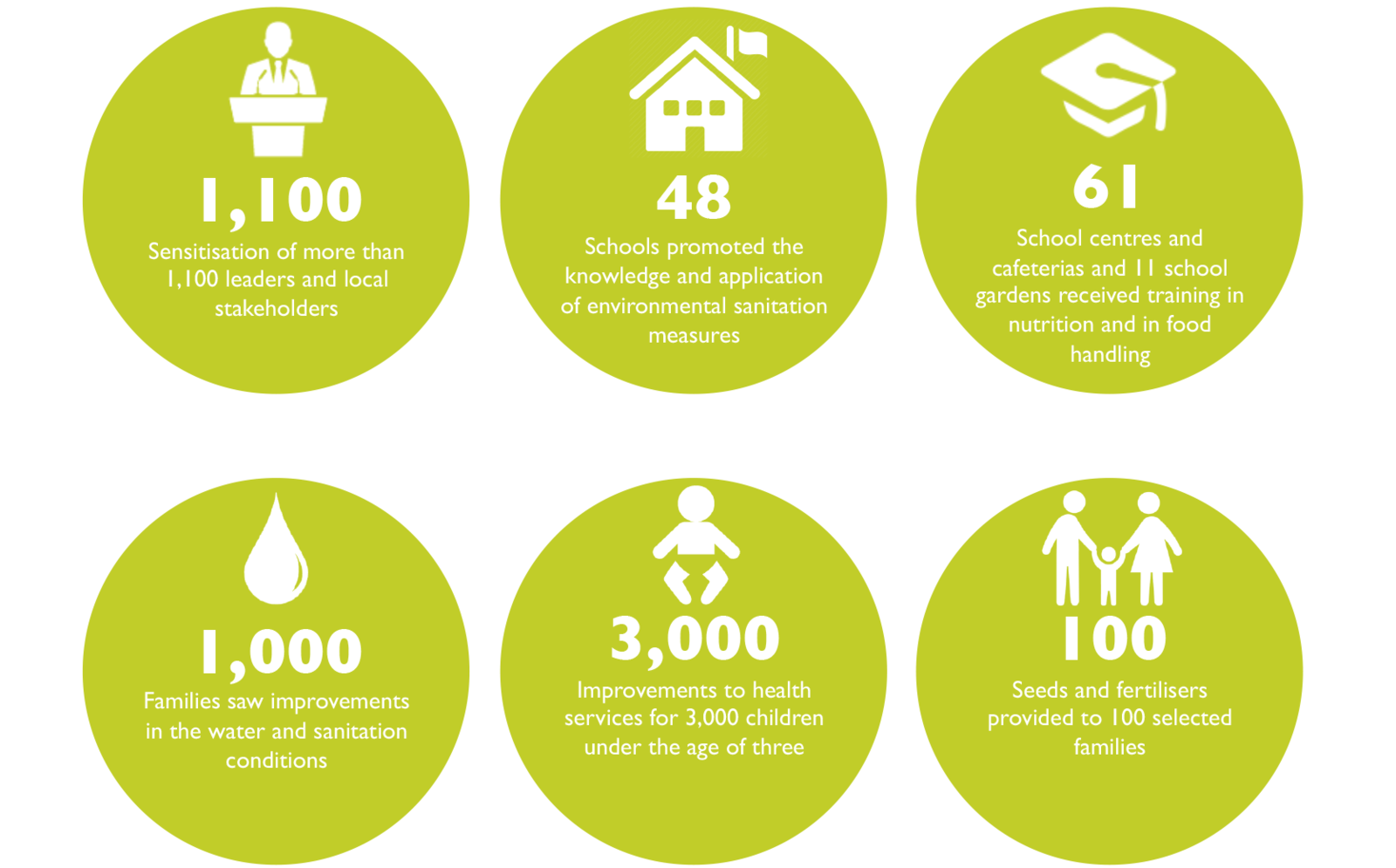
5. CHALLENGES
- There were difficulties in the design phase of the programme. One of the UN agencies involved in setting up the intervention did not then sign the project document. The activities which were associated with that agency had to be taken on by other agencies, mainly by UNDP. This did not affect the achievement of results, but it did have repercussions at administration level. It is important for agencies to make a commitment from the beginning.
- In the first year, a problem arose through the failure to sensitise political leaders and those in technical roles on the importance of an integrated inter-sector approach to nutrition and food security. Educating and raising awareness around the need for the intervention and its methodology proved vital to securing the commitment of the stakeholders involved.
- The fact that the programme was implemented over such a wide geographical area made it a little more difficult to achieve the objectives, outcomes and goals.
- The habits, customs and cultural practices of the population mean a prolonged process is needed to make behavioural changes aimed at better health and nutrition.
- During the implementation, the municipal election periods caused tension between the various sector stakeholders, and resulted in changes in the public authorities. This led to a transition process which delayed the activities.

6. LESSONS LEARNED
- The programme constitutes a successful example of the capacity and impact of the United Nations when its agencies work in a coordinated multidimensional way. Each agency contributed its own knowledge and experience. However, in order for interventions to be successful it is very important for the roles of the different agencies to be made clear and for agreements to be established around the common objectives, thus providing mutual learning for the agencies and linked institutions. Inter-agency coordination is a process requiring time, willingness, tolerance, discussion spaces and mechanisms that reach all levels (management and operational) and enable it to progress.
- The existence of national policies on nutrition and food security facilitates access to finance, and the development and implementation of the programme interventions.
- It is essential to carry out an analysis prior to the intervention in order to understand the strengths, weaknesses, opportunities and threats that exist in the national context, with a view to building an institutional environment for nutrition and food security. Accurate information is key to developing public policies and making sound decisions.
- When decision-making is too centralised this weakens the management and ownership of interventions at departmental and municipal level. Conversely, inter-sector coordination is possible at local level but becomes more difficult moving up to departmental level, and even more so at central level.
- The coordination of several stakeholders requires an inclusive and participatory leadership with clear objectives. When selecting staff for this role these characteristics must be taken into account. The leadership style of whoever is leading the processes is projected onto the rest of the team.
- The involvement and sensitisation of all the parties involved was key to securing support and alliances with municipalities. It is important to respect and appropriately plan for the different processes and time frames of each of the parties to avoid overload of activities.
- The community socialisation spaces, such as educational fairs for sharing key practices with participating schoolchildren taking the lead, were very successful and generated interest and expectations among the families and communities. The inter-cultural community dialogues were a key methodological tool for replicating the activities.
7. SUSTAINABILITY AND POTENTIAL FOR REPLICATION
The intervention can serve as a point of reference for further food security projects carried out in El Salvador, and is also applicable to other countries wishing to strengthen their institutional environment for dealing with the nutrition issue from a multi-sector perspective. Although it is not easy to assess with absolute certainty the sustainability of the impact produced by the programme, it is clear that the level of ownership and leadership of the partners, as well as the alignment of the interventions with their own policies and needs, can be a guarantee that these actions will be maintained in the future.
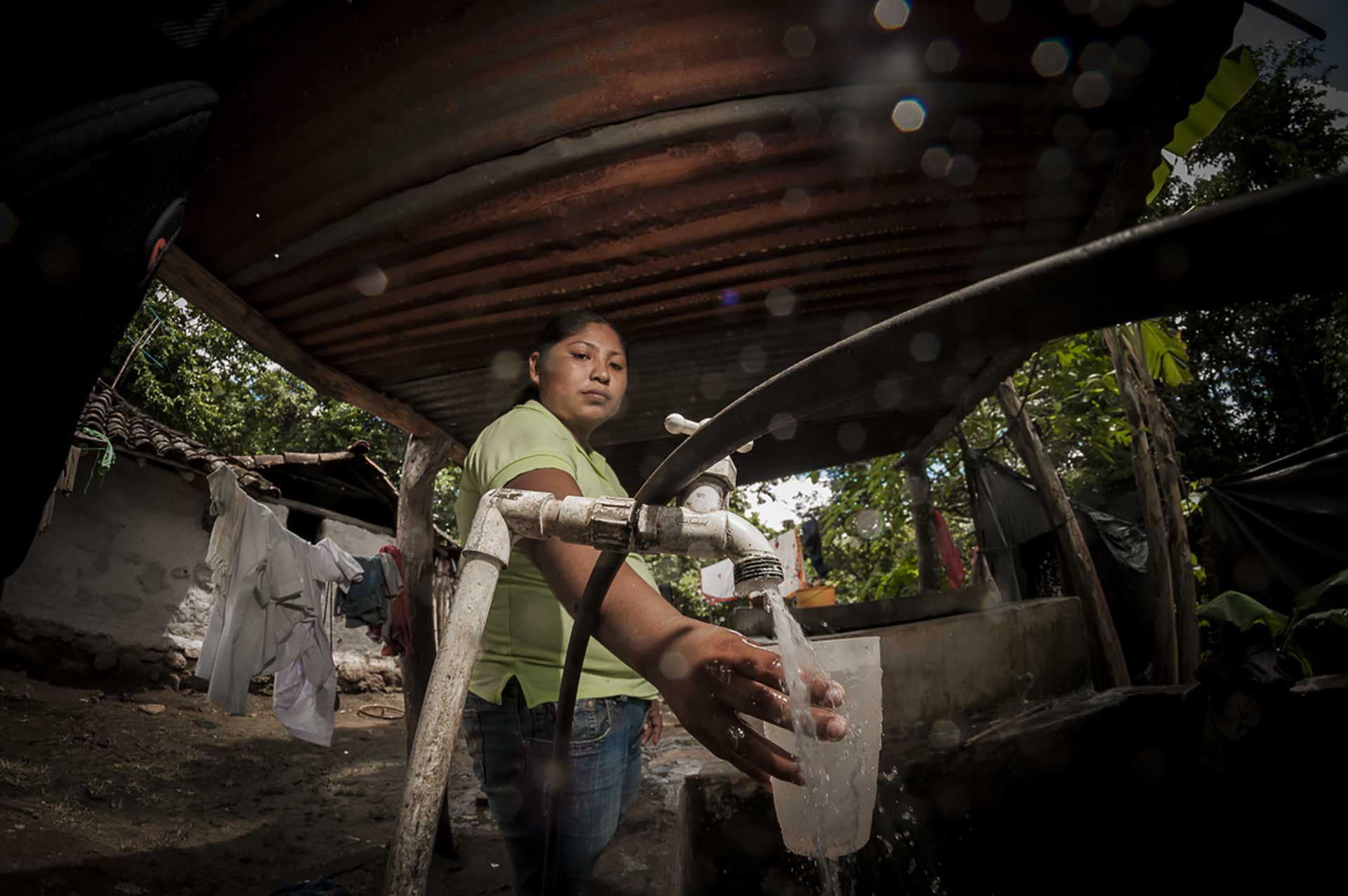
Access to safe drinking water and food preparation is key to improving food and nutrition
To guarantee the sustainability of the actions it is also important for food security programmes to involve multiple focuses. The donation of food and seeds must be coupled with many other elements. For example, the component of food and nutrition education involving various stakeholders is an appropriate strategy for sharing key practices aimed at improving the health and nutrition status of the population. At the same time, linking actions with environmental health initiatives, such as quality control of drinking water, was essential for preventing infectious disease. It is also important to have links with the agricultural component.
Work must also be done on strengthening institutions and having an appropriate legal framework. Currently CONASAN has a crucial role as the country’s governing body for national inter-institutional coordination on nutrition issues. Its structure and staff who were initially supported by the programme were absorbed by the national budget. Various factors such as strengthening CONASAN, managing the information system, and the process of consolidating the inter-sector municipal committees at local level facilitated decision-making in pursuit of strategies directed towards reducing levels of malnutrition.
At the same time, the Law on Nutrition and Food Security sets out legal and technical mechanisms that allow CONASAN and the institutions involved in food security to have legal backing for fulfilling their roles, which also ensures the sustainability of actions to achieve the outcomes in the short, medium and long term.

